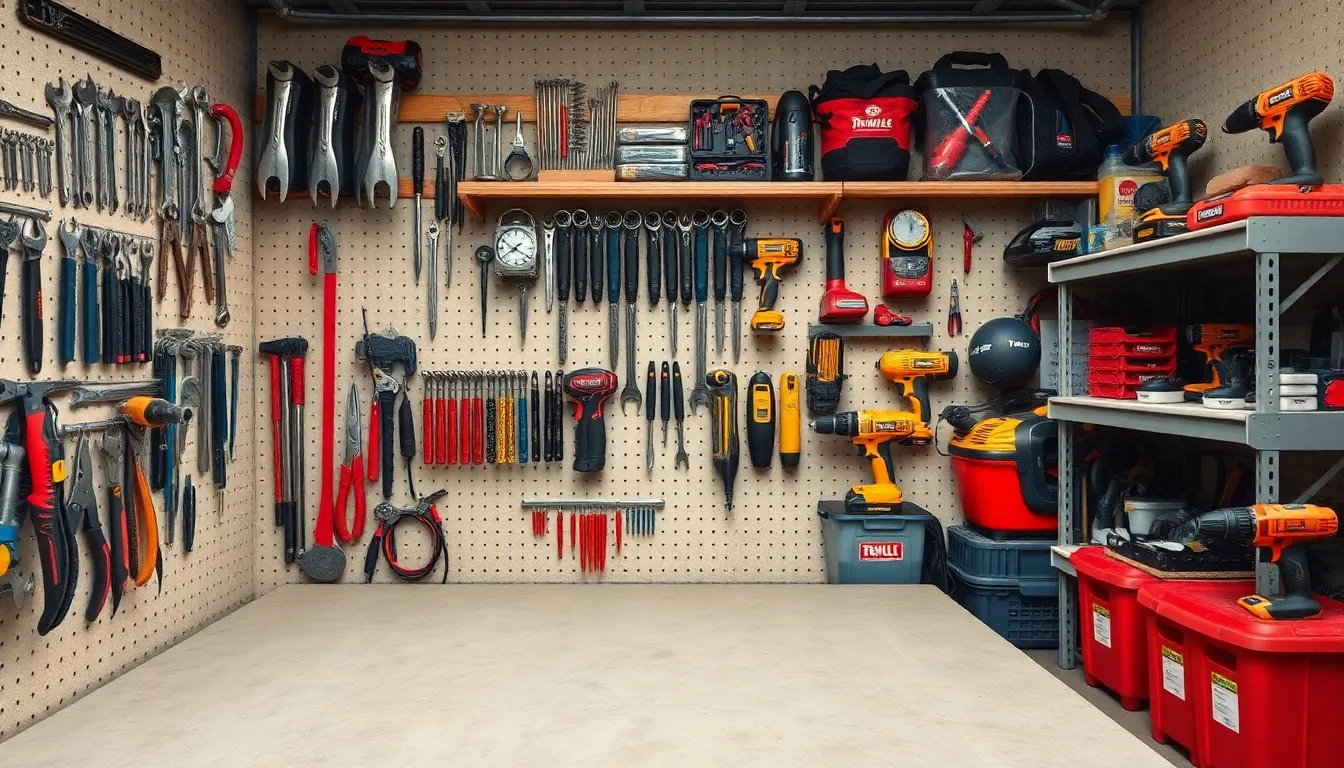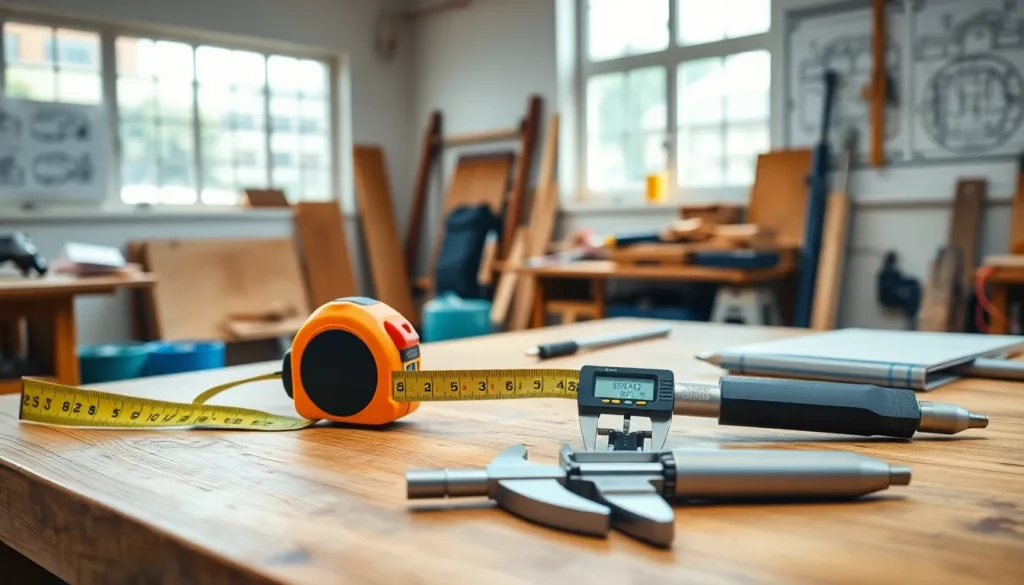Every workshop has that moment when tools seem to multiply like rabbits. One minute, there’s a neat row of wrenches, and the next, it looks like a tornado hit a hardware store. If you’ve ever wasted precious time searching for that elusive screwdriver or tripped over a rogue hammer, you know it’s time to take action.
Table of Contents
ToggleImportance Of Organizing Tools
Organizing tools in a workshop promotes efficiency and productivity. Searching for tools wastes time and creates frustration. When everything has a specific place, it becomes easy to find what’s needed quickly.
Space management also benefits from organization. Tools stored in an orderly fashion maximize storage efficiency. This arrangement prevents overcrowding, which can lead to accidents. Ensuring safety in the workshop protects workers and enhances focus.
Additionally, organizing tools helps in maintaining them. Proper storage reduces wear and tear. Tools kept in designated places experience less damage and degradation. Regular maintenance becomes easier when tools are accessible.
Moreover, organized tools enhance workflow. Working with an established system allows for fluid transitions between tasks. It minimizes distraction, allowing for a more directed effort on projects.
A well-organized workshop reflects professionalism. Customers and clients appreciate a tidy space. Such an environment conveys attention to detail and dedication.
Lastly, an orderly space can foster creativity. When clutter is minimized, the mind can focus better on innovative solutions. Creativity often flourishes in environments that promote organization.
Investing time in organizing tools yields significant returns in productivity and safety. Adopting effective strategies leads to a more efficient and enjoyable workshop experience.
Types Of Tools To Organize

Organizing different types of tools enhances efficiency and keeps the workspace tidy. Understanding the types of tools helps in applying the right organization methods.
Hand Tools
Hand tools include items like wrenches, pliers, and screwdrivers. These tools often require immediate access during projects. Using wall-mounted racks can keep them visible and within reach. Toolboxes or drawer organizers work well for smaller hand tools, allowing for categorized storage. Magnetic strips provide an effective solution for wrenches and screwdrivers, enabling quick retrieval. Additionally, labeled containers offer clarity, helping to identify specific tools easily.
Power Tools
Power tools encompass drills, saws, and sanders. These tools require special consideration due to their size and weight. Utilizing shelving units can create dedicated spaces, ensuring stability and safety. Carts with wheels can aid in mobility, allowing easy movement between work areas. Cord management systems are essential for avoiding tangles and preventing hazards. Lastly, storing power tools in cases protects them from damage and dust accumulation, extending their lifespan.
Best Practices For Tool Organization
Organizing tools effectively leads to enhanced efficiency and productivity in the workshop. Following best practices ensures easy access and a clutter-free workspace.
Sorting By Use
Sorting tools by their intended use simplifies access. Group hand tools like hammers, pliers, and screwdrivers together. Power tools, such as drills and saws, should form their separate category. Categorizing allows for quick retrieval, minimizing time spent searching. Designating specific areas for frequently used tools can improve workflow. For specialized tasks, housing unique tools in identified sections streamlines operations. Keeping similar tools together fosters a logical layout that enhances efficiency.
Utilizing Storage Solutions
Utilizing appropriate storage solutions maximizes organization. Wall-mounted racks or pegboards effectively display hand tools, making them easily visible. Toolboxes enable categorized storage and can house multiple tools efficiently. Magnetic strips offer a convenient spot for quick-access tools, enhancing retrieval. Shelving units work well for larger power tools, while mobile carts allow for easy transport across the workshop. Implementing cord management systems prevents tangling, promoting a safe environment. Labeling containers ensures tools remain in their designated locations for straightforward identification.
DIY Tool Organization Ideas
Organizing tools effectively enhances efficiency in a workshop. The following strategies provide practical solutions for keeping tools accessible and neatly arranged.
Wall-Mounted Storage
Wall-mounted storage is an excellent solution for maximizing space. Pegboards allow for versatile tool hanging, providing easy visibility and access. Magnetic strips keep metallic tools securely in place. Hooks offer additional options for hanging larger items, such as levels and pliers. Using shelves consolidates smaller tools or containers, allowing for better organization while keeping them off the work surface.
Drawer Organizers
Drawer organizers add order to tool drawers, preventing chaos. Adjustable dividers allow customization based on tool size and type. Organizing small items like screws, nails, and bits in separate compartments streamlines workflow. Drawer trays for hand tools provide clear visibility and easy retrieval. Utilizing labeled containers within drawers further enhances organization, ensuring everything has a designated spot. Maintaining a systematic approach in drawers reduces downtime when searching for tools, ultimately improving efficiency in the workshop.
Maintaining An Organized Workshop
Establishing and maintaining an organized workshop requires consistent effort and strategic planning. Regularly evaluating the workspace aids in keeping tools efficiently arranged. Implementing a routine clean-up schedule helps prevent clutter and promotes organization.
Utilizing storage solutions that accommodate specific tools enhances accessibility. Tool chests, pegboards, and shelves serve as effective systems for organization. Each tool should have a designated spot, ensuring easy retrieval and return. Introduce labels for containers and shelves to simplify identification.
Regularly reviewing tool condition assists in maintaining functionality. Dull blades and corroded tools decrease efficiency and pose safety risks. Scheduling routine maintenance reduces wear and prolongs tool lifespan.
Creating dedicated zones for specific activities fosters an organized atmosphere. Designating areas for cutting, assembling, and finishing tasks minimizes distractions. Clear separation of zones allows for smoother workflow and enhances productivity.
Encouraging proper tool placement nurtures responsible work habits. Each workshop member should understand the organization system and adhere to it. Regular training or brief discussions on best practices helps reinforce the importance of maintaining an organized space.
Lastly, adopting a “one in, one out” policy prevents tool accumulation. When introducing new tools, removing old or unused ones retains an organized environment. This proactive approach supports sustained efficiency and enhances overall workshop productivity.
An organized workshop transforms chaos into efficiency. By implementing effective storage solutions and maintaining a structured approach, individuals can significantly enhance their productivity and safety. Regular evaluations and a commitment to keeping tools in designated spots ensure that clutter remains at bay.
The benefits of an orderly workspace extend beyond mere convenience. It fosters creativity and professionalism while creating an environment conducive to innovative thinking. By investing time and effort in tool organization, anyone can enjoy a more streamlined and enjoyable workshop experience. Embracing these practices not only saves time but also cultivates a sense of pride in one’s workspace.










